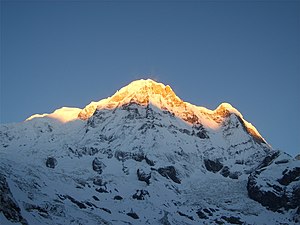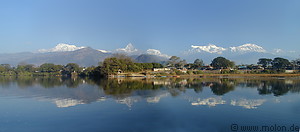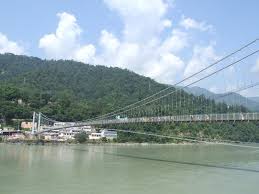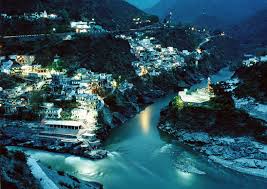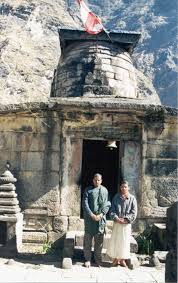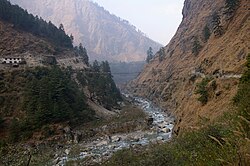
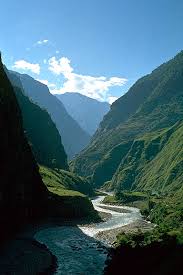
This is the deepest between two mountains in the World. Our travel is along the river on the river banks. We can see the beautiful mountains. We can see clouds below the mountain peaks. We wonder at the sight of green vegetation on the hill range. This place is called Kag Beni; Kag means crow, and beni means offering food to deceased ancestors - pindam [பிண்டம்].

It seems annually or monthly, Nepalese people come here and offer food and perform tarpanam [a sort of ritual] to deceased ancestors. Kag or crow is considered to represent Dharmaraj, god of deceased. From below if we look up at mountain, it appears like a huge curtain! From here at about 11 KMs, up hills, we can find Damodara kund or Mustang in Nepalese. From there Gantaki starts her journey. Once Gantaki meditated on Sriman Narayana. When the Lord appeared before her, she wanted the Lord to be her Son! The Lord after a pause agreed to be in salagrama stones and remain in the river Gantaki; He further said that these Salagrama stones will be in houses and people will thus worship Him. Thus this place itself came to be known as Salagramam. Wind blows here forcefully and it will be an experience to visit this place. While we spend huge sums of money in visiting many foreign countries, we can see in our own country and in Nepal, wonderful places and also sacred places glorified by Alwars! Tirumangai Alwar has praised this place. People visiting this place should carry with them enough protective materials like sweater, woolen socks, gloves, etc. Now, we will see sloka 5 of Chapter 18. Sri Krishna earlier told an opinion of a group of persons, who felt that all karmas were to be discarded as they had drawbacks, like hurting animals or others. But in His opinion, those karmas were not having any defects and were to be performed. In this sloka also one might get some doubts. When one is desiring to reach Moksham, why karma is necessary? We have come across many persons, who claim that they had obtained enough Gyana and so there was no need to perform karmas like Tarpanam or Sandyavandanam. They think doing such karmas are very low level and they are at higher level of Gyana! In this sloka, the Lord refutes such opinions. When one is performing Upasana or Bhakti to attain Brahmam, it is Upasana, that takes one to Moksham. It is true. Where is the role of karma in this? If we want to specialize in Commerce, why study Physics? Upasana involves meditation, while karmas mean lots of activities. At a glance, there appears to be two contradicting things. Next, we may get another doubt. Karmas only lead one to Gyana about Brahmam. At least for this, karmas have to be done. But Gyana about Brahmam is obtained by studying Vedas. Performing sandyavandanam or tarpanam, will not lead to Gyana about Brahmam. So, why at all karmas? Thus it might appear that by both these arguments, karmas are not helpful to realize and reach Brahmam. Does karma help in, at least, firming up our Upasana? No. It is our clarity of mind and Gyana, will stabilize our Upasana, and not karmas. Therefore, it may appear karmas are unnecessary. Therefore, those people argue karmas are to be discarded. But Sri Krishna does not agree and tells Arjuna that karmas are necessary. According to Him, karmas like Yagna, Tapas, Danam, etc., help Upasana. 'Sannipatya upakarakam' means, there could be impediments to start an action. Unless they are cleared one could not start the action. By doing something else, those impediments are cleared. Now that the work has been started, can we discard that something else? No. Because, while progressing with our action to reach the desired result, there could be impediments on the way. Those also are to be cleared and we need that something else again to clear and continue our work. Now, taking this analogy, we can explain that we had to start Upasana. But we find impediments, like papa, which are with us from many births. To remove this papa and make us pure, we require to do karmas. Thus doing karmas continuously, will remove the impediments to start Bhakti or Upasana. We have started Bhakti. It is not that the next moment we would get Moksham. Bhakti has to be continued for a long time. During this process, we might encounter impediments now and then. To remove these impediments also, same karmas are required. This is what the Lord tells in this sloka:
yajñadānatapaḥkarma na tyājyaṃ kāryam eva tat
yajño dānaṃ tapaś caiva pāvanāni manīṣiṇām 18.5
Yajna dana tapa karma = karmas like Yagna, Tapas and Danam, na tyajyam = are not to be relinquished. Here categorically, Sri Krishna refutes the opinion of the group, which said that all karmas were to be relinquished as they had defects. Karyam eva = they are necessary duties, [because], yajna danam tapas caiva = even Yagna, Tapas and Danam, pavanani = [are capable of] purifying, manishinam = people. Manishina means those capable of thinking. People think how to perform Upasana or how to get liberated from samsaram, etc. For such people these Vedic karmas are agents purifying them and removing all obstacles. Thus karmas are inevitable. Brahma Sootram and Chandokya Upanishad reiterate this only. In Chandokya Upanishad [8.15.1] it is said '..sa khalvevam vartayan yaavadaayusham.. [स खल्वेवं वर्तयन यावदायुषं]' - we have to continue with our karma till our journey to reach Moksham, is there. As long as Bhakti is continued, karmas have to be followed. Brahma Sootram says [4.1.12] 'Aaprayaanat, tatraapi hi drushtam [आप्रायणात, तत्रापि हि दृष्टं]' - as long as journey is there or as long as Upasana is practiced, until Moksham is reached, karmas have to be performed. So, nitya- naimittika karmas are necessary as they purify us.



